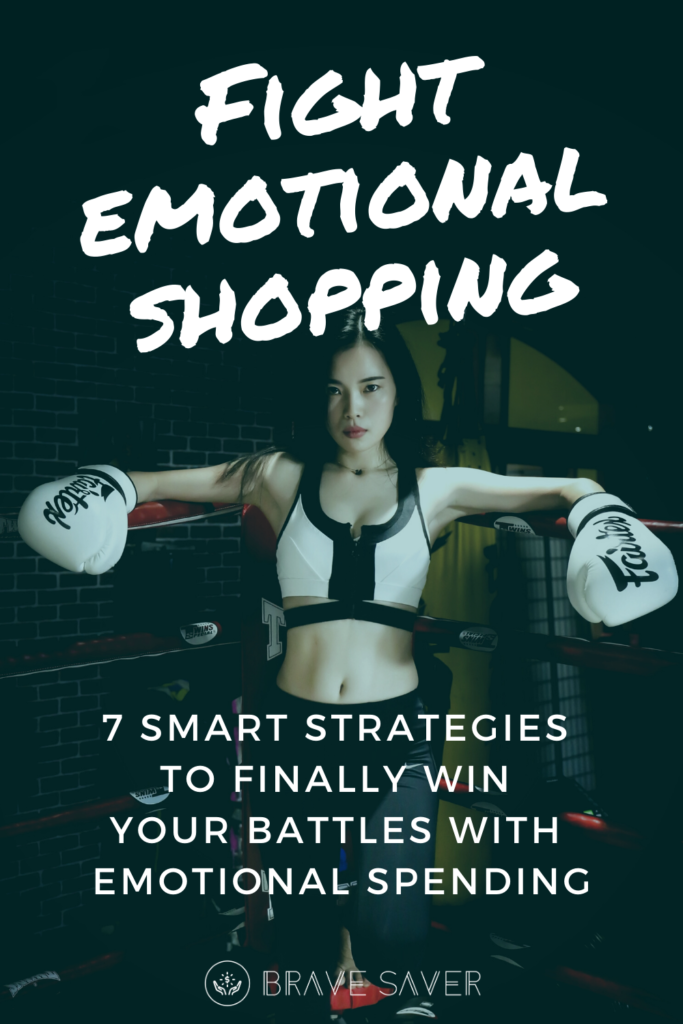
“Reminder: Don’t miss your on your special offer…”
“20% OFF ✨ on all Winter Essentials!”
“AHH! This FLASH SALE ends TONIGHT!”
These real subjects of emails I received today (that inspired this post’s title) are designed to trigger FOMO and emotional shopping. Honestly, sometimes it works — and it’s not just emails like this that get me to blow my budget.
There are a lot of reasons we turn to emotional spending, and understanding what drives poor spending habits can help us figure out how to change them.
But understanding and knowing better, on its own, doesn’t always translate to doing better. I’ve also worked to organize my finances in a way that blocks impulse buys and emotional shopping.
Here are the steps and strategies that I rely on most to fight emotional shopping and spend with more intention and purpose.
What's in this post
1. Get data on your emotional shopping
I need a firm grasp of the damage and shape of my spending issues to know how to change it or how much to correct for. And that means facing the reality of my finances and how emotional shopping is affecting them.
It’s time to dig into bank account statements and receipts to see where, when, and how much I’m dropping when I emotionally spend.
Action: Review transactions to look for trends
Take a hard look at your own spending habits and record the trends:
- Are you more likely to spend on certain days, or at certain points in your paycheck cycle?
- Did spending coincide with other stressful events, like a work eval or visit to the dentist?
- What types of purchases do you tend to make impulsively — is it ordering takeout, buying electronics, or purchasing movies or books?
- Do you tend to shop online or in person? Or is it add-on purchases when you’re at the grocery store or gas station?
- How much are you spending, and how does that compare to your budget?
It’s too easy to fool myself that I’m not spending that much or ignore problems with my budget. Sometimes, I need the reality check of an honest look at my spending data.
2. Make it harder to impulse shop
I can’t rely on my willpower to save me from emotional spending, because this behavior happens exactly when my willpower is weakest!
When internal support like willpower or good decision making fails me, thats a sign that I need to build out external support for my desired behavior.
In this case, it means adding friction and obstacles to my shopping process. The goal is to make overspending and other unwanted money behaviors harder and more of a hassle to complete.
Adding friction and steps to a process gives me more chances along the way to check myself and my behavior.
Action: Add friction to your shopping flow
Here are some strategies that have been really effective in curbing my emotional shopping, whether that’s online or in-person:
- Go cash-only and leave debit and credit cards at home when shopping or heading out.
- Unsave credit card numbers from browsers and online shopping accounts.
- Block retail sites with a site blocker like StayFocusd to limit when you can visit or how long you can spend on retailers’ sites.
- Remove credit card or bank accounts from Apple Pay, PayPal, or other payment services you tend use when you spend.
- Separate savings from everyday money, and preferably move it to a separate bank altogether, to make it less tempting to dip into savings to shop.
3. Make yourself marketing-proof
We’re marketed to and influenced to spend money all day, every day — and whether we notice or not, these messages influence our spending.
Maybe the Instagram ad algorithm has you nailed, and keeps showing you irresistible promotions. Or you saw a sale advertised in your inbox from a favorite brand. If an influencer you follow raves about a product, you suddenly need it, too.
Advertising and even consumer-focused content can normalize overspending and create a sense of FOMO. Or sometimes, it simply captures our attention when we’re already bored, stressed, or emotionally vulnerable. Next thing we know, we’re emotional shopping yet again.
Action: Identify and remove spending triggers
But, you’re not powerless here! You can limit your exposure to marketing and other spending triggers.
What gets you thinking about making a purchase? What triggers you to actually buy it? If you answer that, you can home in on where you need to be blocking unwanted negative influences on your spending habits:
- Clean out your email and unsubscribe from brand mailers that get you to browse, shop, or spend.
- Unfollow people and accounts who trigger the itch to spend, to buy more and better things to keep up.
- Unsubscribe from consumerist, shopping- or product-based accounts or YouTube channels.
- Pay a little extra for a music or TV streaming service that’s ad-free.
- Resist the urge to open those catalogs or ads in your mail — just put them straight in the trash.
- Install ad blockers to limit how much you’re marketed to.
- Don’t fall for the FOMO of limited editions, flash sales, or hyped-up product launches.
- Consider a social media fast or no-spend period to help you “reset” your shopping behaviors.
4. Practice smart shopping habits
Controlling emotional spending has to include trying not to make meaningless or thoughtless purchases, sure. But it also means that when I do spend, I do so with intention and thought.
Through figuring out a smarter buying process, I now have a system that supports me in making better choices that align with my money goals.
In addition to following the steps already laid out, I’ve also spent a while developing a smarter shopping process. It includes methods, rules, and strategies that encourage me to check my worst impulses and spend money with more purpose.
Action: Design a smart shopping process
A smart shopping process is personal and will look different for everyone, because it should be based on what you know about yourself and your shopping habits. Still, here are some examples of the rules I’m following or steps I’m taking as I’m thinking through a purchase.
- Start with skepticism. When product catches my eye, I interrogate the shopping impulse. Do I really need or want it? Do I already own something similar? Will I actually use it?
- Make a “Maybe Buy” list. I curate a list of products I’m interested in, and sometimes simply adding an item to this list will satisfy a shopping itch. It also helps me work out which items I think are just cool vs. which I think are special enough to own.
- Prioritize purchases. Only buy what is both important (Is it necessary or a high priority?) and urgent (Do I need this now or can it wait?). If it’s not both, I’ll put it on hold to think about and consider.
- Wait at least a week. Giving myself a big “cool down” period between a shopping urge and checking out is crucial. And even if I do decide to buy it after waiting a week, I feel more confident it’s a purchase I’ll enjoy.
- Look for the best price. When I decide to make a purchase, I try to pay less. Compare prices, look for coupons or discount codes, or wait for a sale. (Otherwise, I try to ignore sales to avoid FOMO and emotional spending triggered by marketing tactics.)
- Shop in the right headspace. When I’m planning to spend, I first I make sure I’m primed to make smart choices. I’ll run through the acronym HALT: am I Hungry? Angry? Lonely? Tired? Stressed? Do I know what I’m buying and how much I can spend? If not, I’ll put the purchase off until I’m in a better place physically, mentally, or emotionally.
5. Budget and plan your emotional spending
Emotional spending has its place! Retail therapy is real — spending can relieve stress, boost our moods, or help us have fun.
I think the most successful budgets make space for fun spending on “wants.” Having treat yo’self spending built into your budget helps you prioritize purchases you enjoy while setting healthy limits on them.
Action: Add a “fun” category to your budget
The key is to spend on what maximizes happiness, and cut back on other expenses we might mindlessly make that are just “meh.”
Simple add a “fun money” line to your budget in an amount you feel is safe and reasonable to spend.
My husband and I both have our own fun money in the budget — sort of an allowance of money we get to spend guilt-free. I can use this however I want, even for emotional shopping, without explaining myself or worrying that an expense will detract from other money goals.
You can even add a more-specific category to your budget or spending plan. In redoing my budget for 2020, for example, I decided to add a new line for makeup and beauty.
Knowing what I’m planning to spend on makeup each month keeps me more aware and accountable for my spending. It gives me a little extra permission to prioritize something I enjoy without any guilt (and within reason). But I also can’t use weasel-logic to justify picking up a palette that’s too expensive, or spending more when I’ve already maxed it.
6. Get more use out of what you own
I’ve noticed a really cool trend of beauty YouTubers trying to get more use out of what they own.
In “Shop my stash/closet” videos, they revisit their makeup collection or clothing they own to give less-loved items a second chance or rediscover old favorites. Or they might start a “Project pan” to use up more of the makeup and beauty products they already own.
These videos have inspired me to consider how I can get more value out of the products I’ve already bought and own. And as a result,
I’m focused less on new things I can buy and instead get excited about finding new ways to use what I already own.
Action: Shop your stash (or your friend’s) first
If I’m feeling an itch to buy a new, fun read so I can escape into a story — well, there are plenty of books on my shelves that I’d happily read or reread. I can probably use some eyeshadows I already own to dupe an exciting new launch. If my coffee maker breaks, maybe I can look for ways to cold brew coffee instead or start using my forgotten French press.
Rediscovering things I own helps curb shopping impulses in two ways. First, I see how much I already have and am not using — proof I don’t need to buy more. And second, I can rediscover a neglected hobby or get creative with using what I own, getting a boost without spending anything.
Even if I don’t own something, I might be able to borrow it if needed — especially if it’s something I only plan to use once or very occasionally. Check a book or movie out from the library, for example. Or borrow a dress from a friend for a work party, or a specialty cake pan from a sister.
7. Feel into and face your emotions
Fixing poor emotional spending habits requires more than just managing your money better, however. I’ve seen the best results when I’ve also focused on managing myself and my emotions more effectively, too.
When a spending impulse arises, I try to investigate. What were the thoughts and feelings that were running just before this urge to spend?
Action: Address emotional needs and build healthier coping skills
I can then identify it and give those thoughts and feelings their space and time. To work through where the shame of driving a beater is coming from. To sit with the sadness or isolation or loneliness. And then I consider what I can do to directly address the emotional need I’m feeling.
Replace shopping with alternate — and FREE — coping mechanisms, stress relievers, and support, too. This ensures I have something else I can do when I want to shop that will still boost my mood and help me deal.
Most of these are not only free, but also better for me and more effective at improving my emotional state than, say, running to Taco Bell or Sephora. Here are a few of my go-tos:
- Call a friend or family member to talk things out
- Get quiet, by meditating or going for a walk
- Take a nap, eat a snack, drink a big glass of water
- Journal, color, or do something creative
- Take a break from my phone or computer
- Indulge in a rewatch or reread of a comfort book, movie, or TV show
- Get physical affection like snuggles, hugs, or back tickles (pets are great for this too!)
Make your money and spending emotion-driven
Having your finances driven by emotions isn’t inherently a bad thing. Yes, we should minimize the negative effects of emotional shopping and spending.
But I’ve also felt the power of leaning into the emotional side of money management. Of finding a bigger reason, goal, desire that is emotionally-charged and powerful.
Our feelings, desires, and wants can actually be some of the most powerful motivators and catalysts for financial change.
If you’re shopping to deal with a toxic job, for example, identify a financial goal to get out of that situation. Maybe you want to start living on a smaller budget so you can take a less-stressful jobs that might pay less.
If you shop out of boredom — think about what’s the most exciting thing you’d love to spend money on. Is it travel? A designer handbag? And figure out how to save for that big, exciting thing.
Whatever pushes you to emotionally spend, try to find a counterbalance: an emotionally-charged reason to save.
Give yourself space to dream big and think about what you want. Find your big “why,” a goal that you have a big, strong emotional attachment and response to that you need to be financially healthy to achieve.
You can use the positive emotions tied to this goal to combat the fleeting feelings that might drive emotional spending. Because you’ll know you’re not denying yourself — just working toward something that’s even more important to you.

Photo by DIAO DARIUS via Unsplash




No Comments